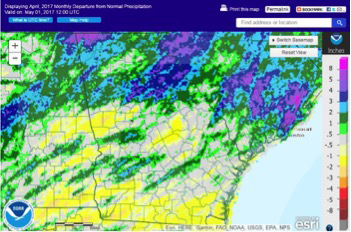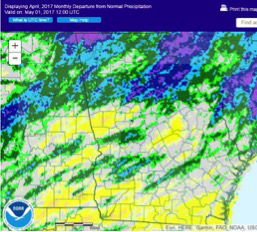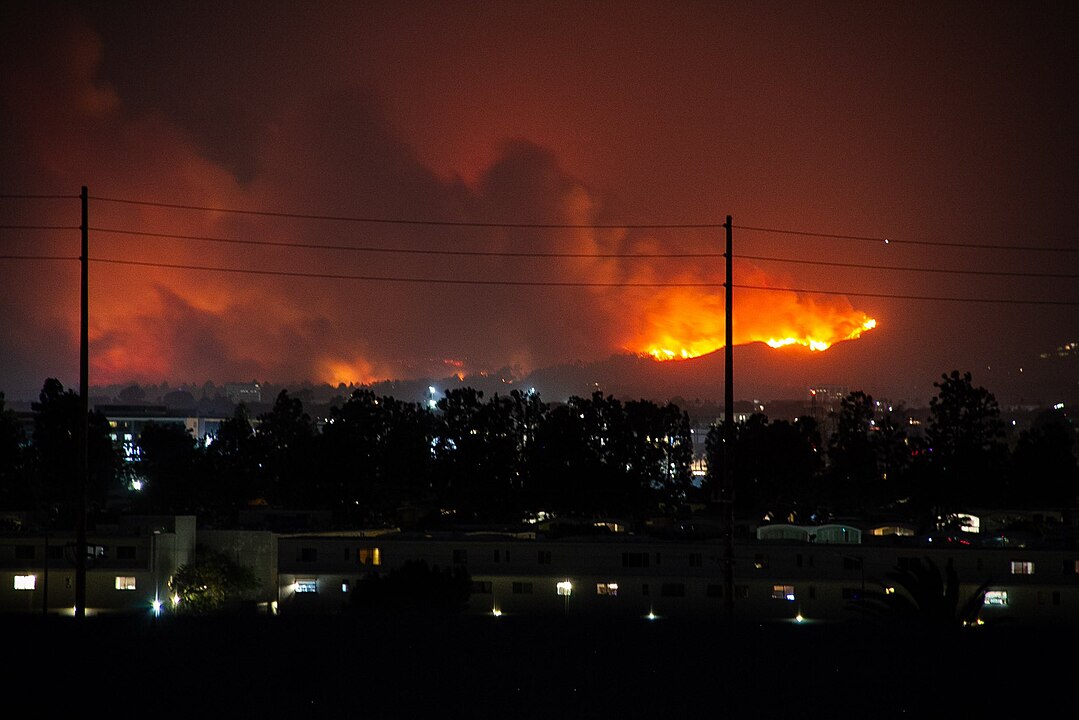April brought plentiful spring showers to north Georgia but little rainfall to the southern half of the state, resulting in moderate drought conditions, delayed planting, and conditions conducive to wildfires near the Okefenokee Swamp.
The lack of rainfall in southern Georgia hindered planting and other fieldwork in the region. Many south Georgia farmers concentrated on planting irrigated acres while waiting for rain in dryland fields. Some farmers are still feeding hay to their livestock in places where pastures have not rebounded from dry conditions in recent months.
Meanwhile, some north Georgia farmers found their planting schedules delayed by soggy fields.
Strawberries improved after the impacts of the mid-March frost, but the wet conditions led to rot in some of the fruit. The lack of chill hours last winter led to some peaches not blooming or leafing out well.
A number of record highs were set in April. Augusta, Georgia, set a new record high of 92 degrees Fahrenheit on April 28, breaking the old record of 91 F set in 2012. Alma, Georgia, recorded 94 F on the same date, surpassing the 92 F set there in 1970. Savannah, Georgia, reported a new record-high nighttime temperature of 73 F on April 30, breaking the old record of 72 F set there in 1953. Alma reported a new record-high minimum of 66 F on April 4, surpassing the old record of 65 F set in 1957. Brunswick, Georgia, reached a low of just 70 F on April 22, breaking the old record of 69 F set there in 1977. Several other records for high temperatures and high minimum temperatures were tied.
Atlanta, Augusta and Savannah all recorded their warmest April on record, which dates back at least 139 years. Athens and Columbus, Georgia, were the second warmest and Macon, Georgia, was tied for fifth warmest.
- In Atlanta, the monthly average temperature was 67.8 F, 5.8 degrees above normal.
- In Athens, the monthly average temperature was 66.7 F, 5 degrees above normal.
- In Columbus, the monthly average temperature was 70.1 F, 5.5 degrees above normal.
- In Macon, the monthly average temperature was 68.2 F, 4.8 degrees above normal.
- In Savannah, the monthly average temperature was 71 F, 5.4 degrees above normal.
- In Brunswick, the monthly average temperature was 71.1 F, 4.6 degrees above normal.
- In Alma, the monthly average temperature was 69.7 F, 3.5 degrees above normal.
- In Augusta, the monthly average temperature was 69.3 F, 6.6 degrees above normal.
- In Albany, Georgia, the monthly average temperature was 70.7 F, 4.5 degrees above normal.
- In Rome, Georgia, the monthly average temperature was 66.6 F, 6.8 degrees above normal.
- In Valdosta, Georgia, the monthly average temperature was 69.1 F, 3.2 degrees above normal.
The area of extreme drought in northern Georgia shrunk during the month but was not eliminated due to long-term precipitation shortages, although recent rainfall has been plentiful. Drought was eliminated from regions just south of Atlanta and Athens due to heavy rains during the month. However, the lack of rainfall in southern Georgia led to the development of moderate and even some severe drought in counties along the Florida border.
The highest monthly total precipitation recorded by the National Weather Service station was 6.86 inches in Athens, 3.71 inches above normal. The lowest total precipitation for April was recorded in Brunswick with 1.59 inches, 0.90 inches below normal.
- Albany received 2.13 inches of precipitation, 1.51 inches below normal.
- Alma received 2.46 inches of precipitation, 0.35 of an inch below normal.
- Atlanta received 5.75 inches of precipitation, 2.39 inches above normal.
- Augusta received 2.6 inches of precipitation, 0.24 of an inch below normal.
- Columbus received 4.41 inches of precipitation, 0.86 of an inch above normal.
- Macon received 3.01 inches of precipitation, 0.05 of an inch above normal.
- Savannah received 2.88 inches of precipitation, 0.19 of an inch below normal.
- Rome received 6.47 inches of precipitation, 2.42 inches above normal.
- Valdosta received 1.94 inches of precipitation, 0.93 of an inch below normal.
The highest daily rainfall total recorded by Community Collaborative Rain, Hail and Snow (CoCoRaHS) volunteers was 5.49 inches near Temple, Georgia, in Carroll County on April 6, followed by 4.87 inches measured at North Decatur, Georgia, in DeKalb County on the same date.
The highest monthly total recorded by CoCoRaHS observers was 9.28 inches, measured northwest of Ringgold, Georgia, in Catoosa County, followed by 8.84 inches reported by a Tunnel Hill, Georgia, observer in the same county and 8.71 inches reported in Loganville, Georgia, in Walton County.
The West Mims Fire in southern Georgia, which was originally sparked by a lightning strike on April 6, burned more than 100,000 acres of the southern Okefenokee Swamp, over one-quarter of the 400,000-acre refuge. There is an evacuation area in St. George, Georgia, area and a number of roads have been closed due to low visibility.
The outlook for May shows an equal chance for near-, above- or below-normal temperatures, which could allow for a break in the 15-month string of above-normal temperatures. Precipitation also has equal chances of occurring in each category, although drought is predicted to expand in south-central Georgia.
For more information, please visit the “Climate and Agriculture in the South East” blog at blog.extension.uga.edu/climate/. To share your weather and climate impacts on agriculture on the blog, email pknox@uga.edu.








